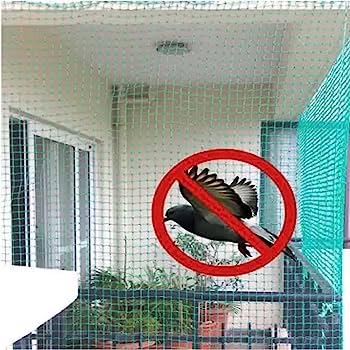Pigeon nets for balconies are a practical and humane solution to the problem of pigeons and other birds gathering and nesting on balconies, which can lead to issues with cleanliness, health, and aesthetics. As urban spaces grow more crowded, buildings often provide ideal environments for pigeons to roost, creating a need for effective solutions. Pigeon nets have emerged as one of the best options due to their cost-effectiveness, durability, and ease of installation.
Why Pigeon Nets Are Necessary
Balconies are often a relaxing spot for homeowners, a place to enjoy fresh air or even a small garden. However, pigeons can quickly make this space unpleasant. Pigeons carry parasites and diseases that can be transmitted to humans through their droppings, feathers, or nests. Common diseases associated with pigeons include histoplasmosis, cryptococcosis, and psittacosis. Accumulated pigeon droppings also corrode balcony materials, leaving behind stains that are hard to remove. These problems not only affect aesthetics but can lead to additional cleaning costs and maintenance work. Given these issues, pigeon nets offer a proactive way to keep balconies clean, safe, and usable.
Features and Materials of Pigeon Nets
Pigeon nets are typically made from high-quality, durable materials like polyethylene or nylon, designed to withstand various weather conditions. These materials are resistant to UV rays, which is essential as balconies are often exposed to sunlight for extended periods. Polyethylene is also waterproof and resistant to mold and mildew, ensuring that the net maintains its structural integrity even during rainy seasons.
The mesh size of pigeon nets is small enough to keep birds out without blocking airflow or sunlight. This makes them ideal for balcony use, as they allow residents to enjoy the natural light and breeze without interference. Nets are often available in different colors to blend in with the building's architecture, ensuring that they don’t impact the aesthetic appeal of the property.
Installation Process
Installing a pigeon net is a straightforward process, but it requires precision and careful planning to ensure maximum coverage. Most providers offer installation services, where professionals measure the balcony area and cut the net accordingly. They secure it using hooks, cable ties, or other fasteners, making sure it covers all potential entry points for pigeons. For individuals who prefer to install the net themselves, kits are available with instructions. However, hiring professionals is often recommended as they have the necessary tools and expertise to provide a lasting solution.
Benefits of Pigeon Nets
-
Hygiene and Health: Pigeon nets prevent droppings and nests from accumulating on balconies, which helps to maintain cleanliness and reduces the risk of infections.
-
Aesthetic Appeal: By keeping pigeons away, the net preserves the visual appeal of the balcony without obstructing views. Many nets are also nearly invisible from a distance, ensuring they don’t interfere with the look of the building.
-
Low Maintenance: Once installed, pigeon nets require minimal maintenance. Occasionally, they may need to be checked for wear and tear, but they typically last for years without needing replacement.
-
Environmentally Friendly: Unlike other methods like spikes or chemical deterrents, pigeon nets are non-lethal and eco-friendly. They don’t harm pigeons but simply create a barrier that discourages them from entering.
-
Cost-Effective: Pigeon nets are an affordable, one-time investment that provides long-term protection. They are significantly cheaper than frequent cleaning or repairing damage caused by pigeon droppings.
Considerations When Choosing a Pigeon Net
When selecting a pigeon net, it’s essential to consider the size of the balcony and the durability of the materials. Quality is a priority, as inferior materials may deteriorate quickly in harsh weather conditions. Additionally, it’s wise to select a provider with a solid reputation for quality and after-sales service, as installation and regular inspection are key to the net’s longevity.
Pigeon nets are highly customizable, with various options in color, mesh size, and strength to fit different needs. For buildings with strict aesthetic requirements, transparent or color-matching nets are available to blend in with the architecture.
Conclusion
In conclusion, pigeon nets for balconies provide an effective, affordable, and humane solution to the problem of pigeon infestations. They protect homes from the health hazards and mess associated with pigeons while maintaining the balcony’s utility and appearance. As urban environments continue to grow, pigeon nets offer a practical approach to coexist peacefully with city wildlife without sacrificing cleanliness, safety, or aesthetics.

